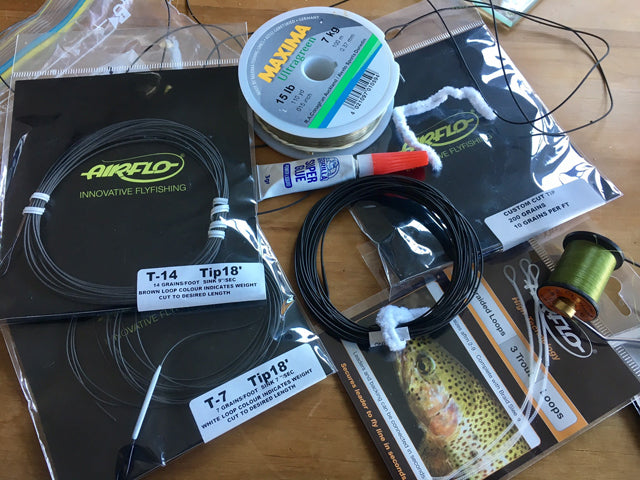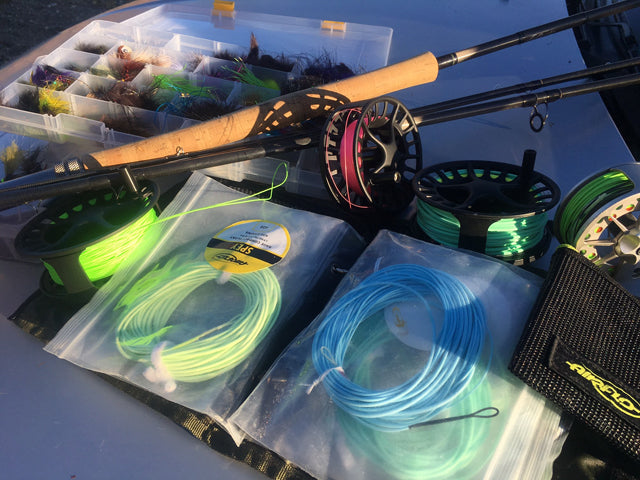Techy Thursday - DIY Sink Tips

When it comes to sink tips for two hand fly fishing we really are spoilt for choice. Airflo Flo Tips and salmon/steelhead weight Airflo polyleaders cover a wide range of angling conditions and are designed to be very angler friendly, however it is the nature of fly fishermen to tinker and customise our rig to better suit our style, the water, and situation at hand.
Airflo have long been the benchmark for sink tips in design, innovation and quality, and due to the unique qualities of polyurethane coating, continue to make the strongest, slimmest loops on the market, and provide a couple of easily customisable options for building your own.
- Airflo 18' Custom Cut sink tips. These 18' lengths of T material come looped on one end, with a handy coloured sleeve indicating weight. T tips are available from T-7 at the lighter end of the range through to T 18 designed to sink like a stone
Customising your tip - the low down…
Grain weight:
Spey lines and sink tips are measured in grains ( 1 grain = 0.065 grams.) To keep things simple, T-10 = 10 grains per foot, T-14 = 14 grains per foot etc, and so a 12' T-10 tip will weigh 120gr, and a 12' T-14 tip will weigh 168gr. The above sink tips are tungsten impregnated and so designed to sink, fast.
Sink rate:
The T designation denotes the density of your material: how quick it will sink to depth. T-7 sinks at 7 inches per second, T-10 at 8ips, T-14 at 9.5ips and T-18 at 11.5ips.
Length:
The length of the tip determines how long your fly will stay at depth throughout the swing. A shorter tip will raise the fly quicker / earlier in the swing whereas a longer tip will keep your fly at depth throughout. A tip thats too short may kick about and become troublesome to anchor whereas a tip that is too long, or heavy may overload the rod, or prove difficult to turnover.
Let's chat:
Employing a longer tip means your fly will remain at depth for a greater portion of the swing, great for wider, more uniform flows. In faster, shallower rocky reaches or for fishing a deeper gut adjacent to a shelf, or gravel bar a shorter tip may prove beneficial so as you don't foul up in the shallows as your fly swings to shore.
In general, I find most anglers I guide are comfortable handling tips of around 10' - 12', and these cover most situations.
Remember, Longer tip = longer stroke whereas shorter tips require a more compact casting stroke. If you're starting out and just getting the hang of spey casting, keep your tips at a uniform length as suggested above for ease of casting.
Construction:
- What you need:
- T Material
- Scissors
- Tape measure
- Airflo braided loops / 15lb nylon
- Loon Uv knot sense + UV torch
- Flytying bobbin and a few different colours of thread
How to:
- Butt end.
- Measure and cut material to length with sharp scissors
- Slide the braided loop over butt end
- Whip a Bind over the braid with tying thread
- Secure the bind with UV knot sense and cure
- Tippet end.
- Repeat the process with a second braided loop. (Tip: colour this loop with black permanent marker to prevent the bright white of the braid whizzing past the fish's nose)
Alternatively, and my personal preference is to tie an Albright knot to a short length of 15lb nylon. Create a perfection loop in the end for an easy loop-to-loop connection to your tippet
Handy tip:
Use a coloured thread binding on the rear loop to indicate weight. I.e.: yellow for T-7 Green for T-14 etc. For quick identification of length you may choose to use 1 bind for 10' tips, 2 separate binds for 14' etc. Formulate a system that works for you.
Dores 2 cents:
Personally I favour 10' - 12' sink tips, the extra length allowing my fly to stay at depth for longer throughout the swing. Shorter come in handy for swinging in across shallower drop offs / bars, and where I don't want my fly too deep in the latter part of its swing. This is also where factory Flo tips come in handy, offering 7.5" of T material with 2.5' of intermediate transition to smooth out the cast. However I also asked my friend, and Oregon Steelhead guru Matt Klara for his thoughts on sink tip length...
Klara speaks:
"Hey Chris. I find a 12ft tip to both fish and cast better in virtually every circumstance in skagit casting. The perfect point in the length continuum of castability and fishability. I remember when I learned I could cut back Rio 15' tips to 12'. That was a breakthrough for me. I feel like you get fewer blown anchors and a less abrupt, slappy turnover, regardless of fly size compared to shorter tips. A longer tip also allows for a deeper BROADSIDE presentation in wide runs. A 15' tip is often too much anchor and runs to deep at the end of the swing to get a good presentation into the hang. Rivers I fish include Deschutes, Klickitat, Sandy, Clackamas, John Day, OR coast, Grand Ronde, Snake, Clearwater, North Umpqua for steelhead. Missouri, Yellowstone, and Madison for trout here in MT, where I also prefer 12' tip, but slower sinking.
I actually almost never go for an 8' tip honestly. I’d rather fish a slower 12' tip. That said, if fish are in slow bouldery flow I will sometimes sacrifice castability and go to a short 8' tip to "hang it' between the boulders. This is typically on inside seams, so casting distance and cleanliness isn’t a priority.
Broadside is a big deal to me especially for summer steelhead and brown trout."
Now go swing!

